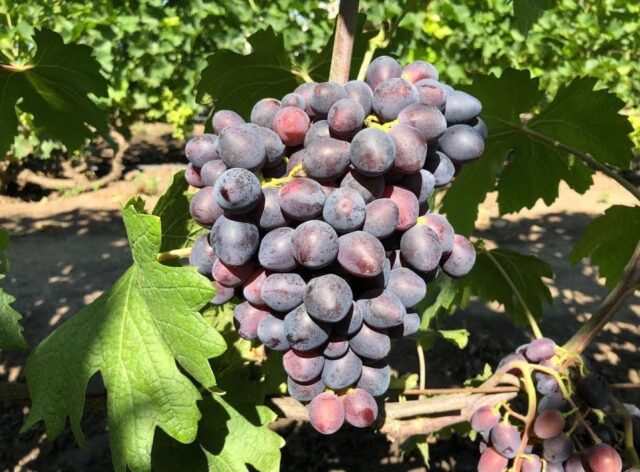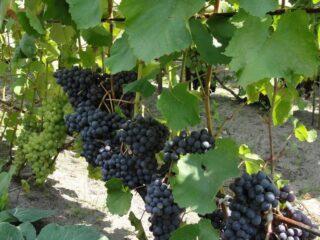Content
Catalonia grapes are a new hybrid form of culture. Despite the fact that the variety appeared only a few years ago, many gardeners have already been able to appreciate it. Catalonia grapes are distinguished by early and abundant fruiting and high consumer qualities, which explains the increased demand for the crop during sales. The growing popularity of the hybrid is also facilitated by its relative resistance to common crop diseases. But for successful cultivation it is necessary to take into account the basic characteristics of the species.

According to the creator, Catalonia grapes are table varieties
History of selection
Catalonia is the result of the work of a national breeder from Ukraine, Alexander Burdak. The goal was to obtain an ultra-early grape variety with a dark shade of fruit, which is capable of showing high productivity with minimal care. And its creator succeeded.However, an application for variety testing in Catalonia has not yet been submitted, which explains its absence from the State Register.
The basis for the grapes was the large-fruited, well-known variety Talisman and the hybrid Krainova Burgundy Mantle. Thanks to this, the resulting species retained the large size of the berries, increased resistance to diseases from the maternal form, as well as a rich dark shade and early ripening from the paternal form.
Description of the Catalonia grape variety
This grape is characterized by great vitality. Due to this, it begins to bear fruit already in the first year after planting. In addition, it has other distinctive features that you should pay attention to.
Bunches
Catalonia has large, wide-conical clusters. However, their size increases as the vine matures and perennial wood accumulates. But the weight of even signal bunches is significantly greater than that of other varieties. It is 400-500 g, and after a couple of years it doubles. The density of Catalonia bunches is average. Thanks to this, the berries are well ventilated, which reduces the likelihood of them being affected by fungal diseases. The length of the bunches is 18-20 cm and the width is 15 cm.
The combs of this grape are elongated and strong. They have a bright green tint with a slightly pinkish tint in some places.
Berries
The fruits of Catalonia are oval in shape. The grapes are large, reaching a length of 38 mm and a width of about 15 mm. The average weight of each is 12-15 g. As the berries ripen, they acquire a rich dark purple hue. And the surface of the grapes is covered with a thick gray coating of protective spring.Their skin is thin and cannot be felt when eaten. At the same time, it is durable and highly resistant to damage.
When harvested early, the skin has a tartness, but after ripening it completely disappears. Each grape has 2-3 seeds, but they are not felt when consumed. Therefore, the taste does not spoil. The pulp has a dense consistency and is crispy.

Berries of Catalonia grapes do not touch during growth
Vine
The hybrid produces many young shoots every year. Moreover, during the season they fully ripen and acquire a reddish-brown hue.
The leaves of Catalonia are large, round in shape, consisting of five segments, characterized by strong ruggedness. The plates are smooth, dark green in color, with pronounced light veins. The recesses at the base are open. The petioles are elongated, green with an anthocyanin tint. The teeth along the edge of the plates are large, saw-toothed or triangular, the sides are pointed, and the tops of the leaves are rounded.
Characteristics of Catalonia grapes
To get a complete picture of this hybrid, you need to study its characteristics. This information will help determine the most favorable conditions for its cultivation and avoid serious mistakes in care.
Ripening period for Catalonia grapes
Catalonia grapes are an early ripening crop. The bunches ripen in 90-100 days from the moment the buds open. But this is possible if the sum of active temperatures during this period is 21-22 °C.
If conditions are favorable, harvesting can be done as early as the end of July. But the grapes reach their maximum taste by the end of the first ten days of August.
Productivity
Catalonia bears fruit regularly.The seedling forms clusters already in the first season, but begins to bear fruit fully 3-4 years after planting. The hybrid needs load rationing. The yield of the variety is 35-40 kg per vine.
Taste of Catalonia grapes
The tasting score of the variety is 8.9 points out of a possible ten. Gardeners also note the good taste of Catalonia. The grapes of the hybrid are sweet, with a moderate aroma. After eating, a taste reminiscent of cherries is felt.
Growing regions
The hybrid is recommended to be grown in the southern regions without shelter. And also Catalonia grapes are suitable for central regions, but with mandatory insulation for the winter.
Frost resistance
The hybrid has an average level of frost resistance. It can withstand temperatures down to -23 °C. However, if the vine freezes, it can quickly recover.
Drought resistance
Catalonia tolerates short-term drought well. But the hybrid reacts poorly to waterlogging. Therefore, watering should be done in doses.

Catalonia grapes cannot be planted in lowlands and marshy areas
Disease resistance
This variety has average resistance to common crop diseases. If the growing conditions are inappropriate, Catalonia suffers from gray rot and chlorosis. Therefore, preventive treatments with fungicides should not be neglected.
Keeping quality
The collected bunches of Catalonia are suitable for transportation. At the same time, they fully retain commercial qualities. The harvest can be stored fresh for 2-3 months in a cool room, but for this it must be removed from the vine at the stage of technical maturity.
Advantages and disadvantages
Catalonia has many advantages, which explains the growth in popularity of this grape in such a short time. But the hybrid also has certain disadvantages that cannot be ignored.

Catalonia is pea-resistant
Main advantages:
- excellent commercial quality;
- good taste;
- early fruiting;
- large fruit;
- suitability for transportation;
- possibility of long-term storage;
- simultaneous ripening of bunches;
- high survival rate;
- excellent rooting of cuttings.
Flaws:
- demands on soil composition;
- intolerance to stagnation of moisture;
- sensitivity of roots to frost.
Features of cultivation
It is recommended to plant Catalonia seedlings in the spring so that they can get stronger before winter. For a hybrid, you should choose a well-lit area on a hill. In this case, the groundwater level must be at least 1.5 m.
Catalonia grapes show good performance on sandy and loamy soils with neutral acidity. Seedlings should be placed taking into account the fact that each requires at least 5 square meters. m of free space. Only in this case will they be able to fully develop and not compete for food.
After planting, during the first months you need to constantly monitor soil moisture. Initially, the seedling should be watered regularly as the top layer of soil dries. And after rooting, moisturize 1-2 times a month. Mature vines need to be watered only in the absence of seasonal rains during bud break, before flowering and in autumn.
Catalonia responds well to feeding.You need to start fertilizing grapes in early spring. During this period, organic matter should be used. With the arrival of summer, the vine needs to be fed with superphosphate (40 g) and potassium sulphide (35 g) per bucket of water. Repeat the procedure once a month.
This hybrid requires regular pruning. Every year its shoots should be shortened to 5-8 buds. It is also necessary to clean the vine from broken and damaged shoots in the spring in order to improve the ventilation of the vine.

The hybrid harvest is not damaged by wasps
Conclusion
Catalonia grapes are a new promising type of crop that deserves the attention of experienced and novice gardeners. After all, there are not so many early dark varieties, and in comparison they are inferior in commercial quality to this hybrid. And the early fruiting of Catalonia allows you to get the first harvest much earlier than other species.
Reviews of Catalonia grapes








